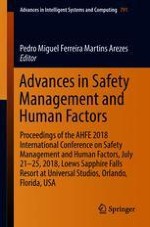2019 | OriginalPaper | Chapter
Expert Elicitation Methodology in the Risk Analysis of an Industrial Machine
Authors : Tony Venditti, Nguyen Duy Phuong Tran, Anh Dung Ngo
Published in: Advances in Safety Management and Human Factors
Publisher: Springer International Publishing
Activate our intelligent search to find suitable subject content or patents.
Select sections of text to find matching patents with Artificial Intelligence. powered by
Select sections of text to find additional relevant content using AI-assisted search. powered by
